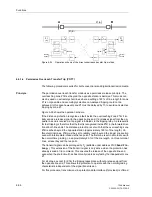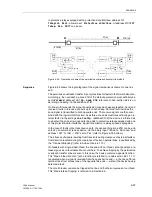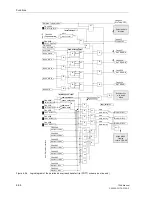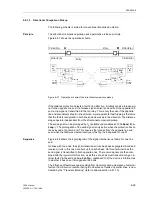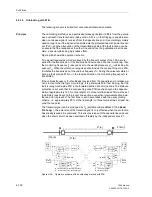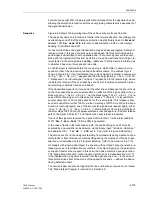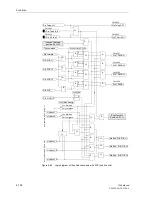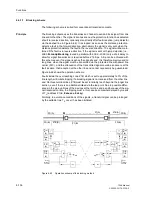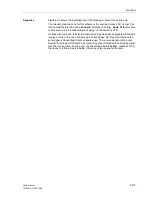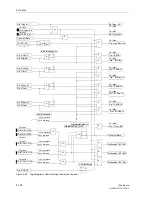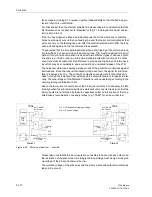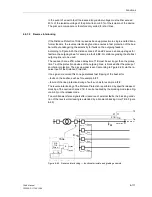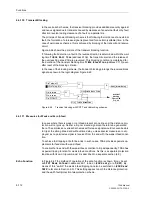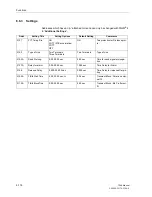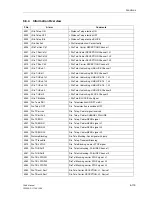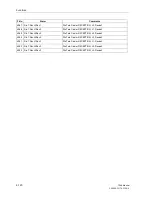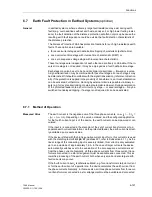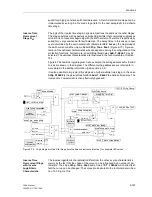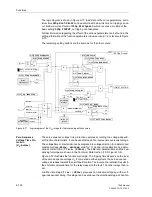
Functions
6-109
7SA6 Manual
C53000-G1176-C156-2
As soon as the Distance Protection has detected a fault in reverse direction, the block-
ing signal is sent (e.g. “
Dis.T.SEND
”, FNo
4056
). The send signal can be prolonged
in address
2103A
. If the fault is in forward direction, the blocking signal is stopped (e.g.
„
Dis.T.BL STOP
“, FNo
4070
). To achieve a very fast-reacting blocking scheme in-
clude the output signal of the jump detector for the send signal. Therefore allocate the
output “
DisJumpBlocking
” (FNo
4060
) also to the output relay to the signal trans-
mitting equipment during configuration. Since this jump signal usually appears when
a measured value suddenly changes, the latter should only be applied, if guaranteed
that the transmission channel has a fast response to the reset of the send signal.
If there is a disturbance in the signal transmission path the overreaching zone can be
blocked via a binary input. The distance protection operates with the usual time grad-
ing characteristic (non delayed trip in Z1). The overreaching zone Z1B can then be ac-
tivated by an automatic reclose function via the binary input “
>Enable ARzones
” and
address
1357
1st AR -> Z1B
set to “Yes” (refer also to Figure 6-38 bottom).
The influence of signals resulting from transients during clearance of external faults or
from direction reversal during the clearance of faults on parallel lines, is neutralized by
the “Transient Blocking”. It prolongs the blocking signal by the transient blocking time
TrBlk BlockTime
(address
2110
), if it has been present for the minimum duration
equal to the waiting time
TrBlk Wait Time
(address
2109
).
It lies in the nature of the blocking scheme that single end fed short circuits can also
be tripped rapidly without any special measures, as the non feeding end cannot gen-
erate a blocking signal.
6.6.1.8
Pilot Wire Comparison
The following scheme is suited for conventional transmission media.
In the pilot wire comparison the overreaching zone Z1B functions as instantaneous
zone at both ends of the protected line. Zone Z1B is set to reach beyond the next sta-
tion. The pilot wire comparison avoids non-selective tripping.
The information exchange between both line ends is carried out via a closed quiescent
current loop (Figure 6-64) that is fed by a substation battery. One NC contact must be
allocated for each signal output, the receiving input must be configured to “low-active”.
Alternatively two auxiliary relay combinations (e.g. 7PA5210–2A) can be used for in-
verting the contact.
In the quiescent state the pilot wires carry direct current that, at the same time, moni-
tors the healthy state of the connection.
If the Distance Protection picks up, the following signal appears: “
Dis.T.SEND
”. The
NC contact is opened and the pilot wire loop is initially interrupted. A trip by Z1B is
blocked via the receiving input „
>DisTel Rec.Ch1
“. If the protection system then de-
tects a fault within the overreaching zone Z1B, the send signal resets. The NC contact
returns to its quiescent state (closed). If the loop in the remote station is also closed
after the same sequence, the loop is energized again: the tripping is again released at
both ends.
In case the short-circuit occurred outside the protected line the pilot wire loop is also
interrupted by the pickup of both devices (both NC contacts “Dis.T.SEND” are
opened). Since the send signal will not reset at least one of the line ends (fault is not
in line direction in zone Z1B), the loop at that end will remain open. Both receiving in-
puts are deenergized and block the tripping (because of “L-active”). The other dis-
Summary of Contents for siprotec 7SA6
Page 2: ...Siemens Aktiengesellschaft Book No C53000 G1176 C156 2 ...
Page 18: ...xviii 7SA6 Manual C53000 G1176 C156 2 ...
Page 32: ...Introduction 1 14 7SA6 Manual C53000 G1176 C156 2 ...
Page 82: ...Hardware and Connections 2 50 7SA6 Manual C53000 G1176 C156 2 ...
Page 119: ...SIPROTEC 4 Devices 4 25 7SA6 Manual C53000 G1176 C156 2 Figure 4 20 CFC Logic example ...
Page 190: ...Configuration 5 62 7SA6 Manual C53000 G1176 C156 2 ...
Page 652: ...Installation and Commissioning 8 78 7SA6 Manual C53000 G1176 C156 2 ...
Page 724: ...Technical Data 10 56 7SA6 Manual C53000 G1176 C156 ...
Page 800: ...Appendix A 76 7SA6 Manual C53000 G1176 C156 2 ...
Page 866: ...Appendix B 66 7SA6 Manual C53000 G1176 C156 2 ...


